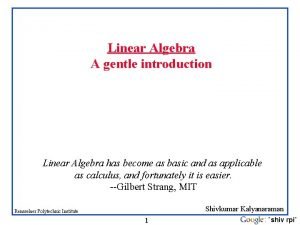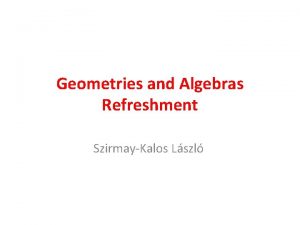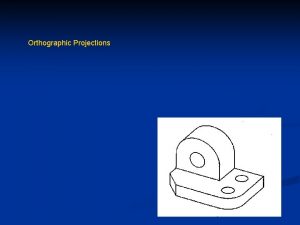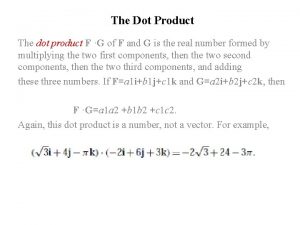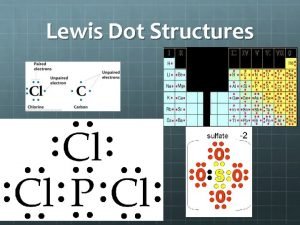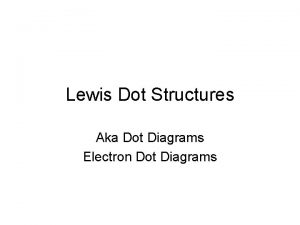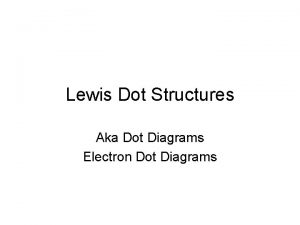Section 3 3 Dot Product Projections THE DOT











- Slides: 11

Section 3. 3 Dot Product; Projections

THE DOT PRODUCT If u and v are vectors in 2 - or 3 -space and θ is the angle between u and v, then the dot product or Euclidean inner product u ∙ v is defined by

COMPONENT FORM OF THE DOT PRODUCT If u = (u 1, u 2) and v = (v 1, v 2) are vectors in 2 space, then u ∙ v = u 1 v 1 + u 2 v 2 If u = (u 1, u 2, u 3) and v = (v 1, v 2, v 3) are vectors in 3 -space, then u ∙ v = u 1 v 1 + u 2 v 2 + u 3 v 3

ANGLE BETWEEN VECTORS If u and v are nonzero vectors and θ is the angle between them, then the angle between them is

DOT PRODUCT, NORM, AND ANGLES Theorem 3. 3. 1: Let u and v be vectors in 2 - or 3 -space. (a) v ∙ v = ||v||2; that is, ||v|| = (v ∙ v)1/2 (b) If the vectors u and v are nonzero and θ is the angle between them, then θ is acute if and only if u∙v>0 θ is obtuse if and only if u∙v<0 θ = π/2 u∙v=0 if and only if

ORTHOGONAL VECTORS Perpendicular vectors are also called orthogonal vectors. Two nonzero vectors are orthogonal if and only if their dot product is zero. We consider the zero vector orthogonal to all vectors. To indicate that u and v are orthogonal, we write

PROPERTIES OF THE DOT PRODUCT If u, v, and w are vectors is 2 - or 3 -space and k is a scalar, then: (a) u∙v=v∙u (b) u ∙ (v + w) = u ∙ v + u ∙ w (c) k(u ∙ v) = (ku) ∙ v = u ∙ (kv) (d) v ∙ v > 0 if v ≠ 0, and v ∙ v = 0 if v = 0

ORTHOGONAL PROJECTION Let u and a ≠ 0 be positioned so that their initial points coincide at a point Q. Drop a perpendicular from the tip of u to the line through a, and construct the vector w 1 from Q to the foot of this perpendicular. Next form the difference w 2 = u − w 1. The vector w 1 is called the orthogonal projection of u on a or sometimes the vector component of u along a. It is denoted by proja u. The vector w 2 is called the vector component of u orthogonal to a and can be written as w 2 = u − proja u.

THEOREM Theorem 3. 3. 3: If u and a are vectors in 2 -space or 3 -space and if a ≠ 0, then (vector component of u along a) (vector component of u orthogonal to a)

NORM OF THE ORTHOGONAL PROJECTION OF u ALONG a

DISTANCE BETWEEN A POINT AND A LINE The distance D between a point P(x 0, y 0) and the line ax + by + c = 0 is given by the formula
 192 dot 168 dot 1 dot 1
192 dot 168 dot 1 dot 1 Cross product outer product
Cross product outer product Contoh soal dot product dan cross product
Contoh soal dot product dan cross product Rumus yang menyatakan cross-product adalah
Rumus yang menyatakan cross-product adalah 8-3 dot products and vector projections answers
8-3 dot products and vector projections answers 1-5 solving equations and inequalities by graphing
1-5 solving equations and inequalities by graphing Java vs dot net
Java vs dot net Linear algebra rpi
Linear algebra rpi Sifat sifat dot product
Sifat sifat dot product Dot product glm
Dot product glm 2 rr
2 rr Lerp
Lerp







